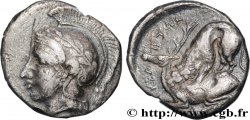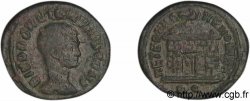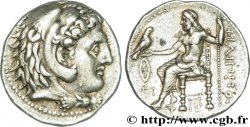v38_0026 - LUCANIA - VELIA Nomos, statère ou didrachme
MONNAIES 38 (2009)
Начальная цена : 280.00 €
Назначить цену : 450.00 €
Цена реализации : 280.00 €
Количество ставок : 1
Максимальная предлагаемая цена : 310.00 €
Начальная цена : 280.00 €
Назначить цену : 450.00 €
Цена реализации : 280.00 €
Количество ставок : 1
Максимальная предлагаемая цена : 310.00 €
Тип Nomos, statère ou didrachme
Дата: c. 305/304- 293/290 AC.
Монетный двор / Город: Vélia
Металл: silver
Диаметр: 22 mm
Ориентация осей монеты: 4 h.
Вес: 7,26 g.
Редкость: R1
Emission: 78e
Комментарии о состоянии
Exemplaire sur un flan très large et irrégulier, bien centré. Très beau portrait inhabituel d’Athéna avec la javeline pointant en avant. Revers parfaitement venu. Jolie patine de collection ancienne avec des reflets mordorés
Ссылки в каталоге: :
Лицевая сторона
Аверс: описание: Tête d'Athéna à gauche, coiffée du casque attique à cimier avec triple aigrette, orné d’un hippocampe ailé ; javeline pointé en avant ; monogramme devant le nez.
Аверс: легенда: DE
Обратная сторона
Реверс: Описание: Lion passant à droite ; trident tourné à droite, au-dessus.
Реверс: легенда: [U]ELHTW[N]/ F-I
Реверс: перевод: (de Vélia).
Комментарий
Mêmes coins que l’exemplaire de la collection Mc Lean (Cambridge, n° 1466) et que celui de l’Hunterian Coin Cabinet de Glasgow, n° 45. Très tôt, le monnayage de Vélia a été décrit comme ayant inspiré la drachme lourde de Marseille (LT. 785-791). Certains l’ont même décrit comme un monnayage symmachique : un lion de Vélia étant l’équivalent de deux lions de Marseille. Aujourd’hui, cette théorie est remise en cause, par G. Depeyrot, non sans arguments, mais avec une certaine acrimonie. Le lion de Vélia a pu servir de modèle à celui de Marseille, mais à quelle date ? La frappe à Vélia commence dans la seconde moitié du Ve siècle avant J.-C. pour se poursuivre jusqu’en 281 avant J.-C. À quel moment les Massaliotes auraient-ils emprunté le lion de Vélia ?.
Same dies as the example in the McLean collection (Cambridge, no. 1466) and that of the Hunterian Coin Cabinet in Glasgow, no. 45. Very early on, the coinage of Velia was described as having inspired the heavy drachma of Marseille (LT. 785-791). Some have even described it as a symmachic coinage: one lion of Velia being the equivalent of two lions of Marseille. Today, this theory is challenged, not without argument, but with a certain acrimony, by G. Depeyrot. The lion of Velia could have served as a model for that of Marseille, but at what date? Minting at Velia began in the second half of the 5th century BC and continued until 281 BC. At what point would the Massaliotes have borrowed the lion of Velia?
Same dies as the example in the McLean collection (Cambridge, no. 1466) and that of the Hunterian Coin Cabinet in Glasgow, no. 45. Very early on, the coinage of Velia was described as having inspired the heavy drachma of Marseille (LT. 785-791). Some have even described it as a symmachic coinage: one lion of Velia being the equivalent of two lions of Marseille. Today, this theory is challenged, not without argument, but with a certain acrimony, by G. Depeyrot. The lion of Velia could have served as a model for that of Marseille, but at what date? Minting at Velia began in the second half of the 5th century BC and continued until 281 BC. At what point would the Massaliotes have borrowed the lion of Velia?








 Cообщить об ошибке
Cообщить об ошибке Распечатать страницу
Распечатать страницу Отправить мой выбор
Отправить мой выбор Задать вопрос
Задать вопрос Consign / sell
Consign / sell
 Информация
Информация











